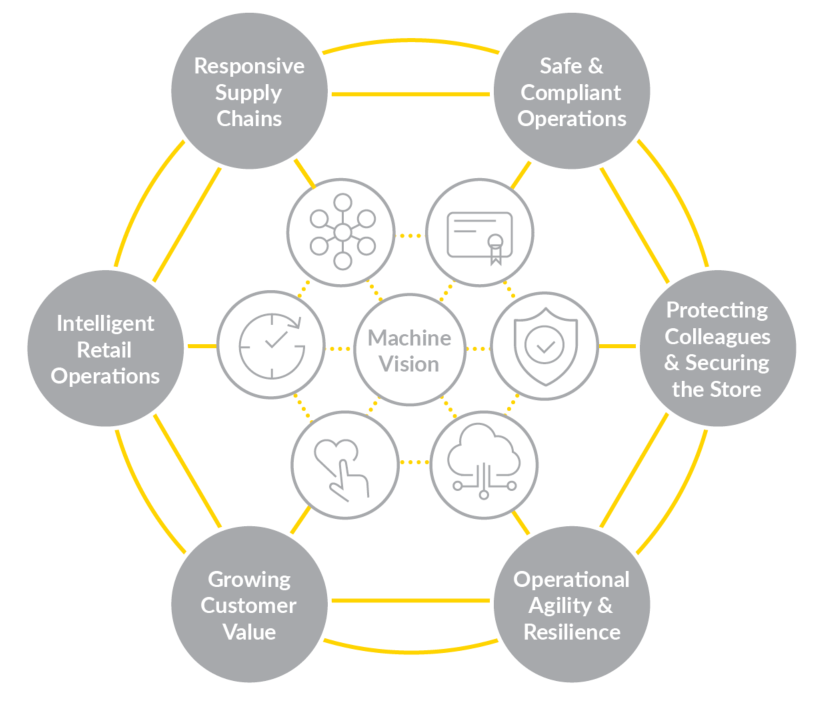Machine vision makes the store of the future, the store of now.
The new Amazon Go stores demonstrate technology can deliver a convenient experience for customers and at the same time reduce operating costs. Many retailers facing a similar challenge of demanding customers and squeezed margins will be watching how this venture progresses closely. Most might not be ready to dive-in with fully automated stores just yet due to cost or practicalities like size of store, but they could benefit from one of the key technologies behind Amazon Go. Machine Vision.
Machine Vision applies artificial intelligence to visual data, captured by cameras that could range from your existing CCTV systems, to specialised heat sensing cameras that can spot variations in fridge temperatures or electrical cabling at distance.
Recent advances in this technology mean that if it can be seen by camera, in most cases it can now be recognised by machine. This turns cameras with machine vision into ‘Omni-sensors’ removing the need for multiple store technologies, such as thermometers, gate controls and footfall counters. For a while, algorithms have been able to tell us not just that a person has walked in, but also their gender, and approximate age. Today the technology has advanced considerably so not only will it recognise physical characteristics, but it will also identify over 100 different behaviours. Want to know when someone is getting agitated and there may be a risk of violence? Want to identify a mobility-disabled customer who might need help? Want to spot an item going into a coat rather than a basket? Want to be certain promotions are displayed correctly? All these can be identified by Machine Vision. Fujitsu’s technology can even ensure that staff are completing all six stages of handwashing. Even though hands come in different sizes, and the movements are complex, subtle and obscured with soap. The recognition of detailed observations will make Machine Vision an indispensable tool for delivering operational efficiency and brand standards for retailers.
In 2021 Fujitsu successfully achieved the world’s highest accuracy against the world standard benchmark in the field of behaviour recognition.
Colleague Safety
The BRC Crime Survey found there were 450 incidents of abuse and violence towards shop staff every day. No surprise then that 90% of retailers say colleague safety is a top three concern for the board. A challenge for store colleagues facing an agitated member of the public is that remaining calm is essential to de-escalate the situation, but at the same time signalling for help can be seen as the very opposite of this. Machine Vision could help here, as it is able to spot or even predict an escalating situation. It could even spot pre-agreed signals from colleagues to raise a silent alarm or even an automated announcement warning of risk of prosecution. This makes it clear that the situation has been spotted, but in a way that draws focus and hopefully danger away from the colleague.
Better and Faster SCO experience
With each Self-checkout unit on average losing over £11,000 a year with non-scans many retailers would be glad of an extra set of eyes here. Machine vision can spot non-scans and product, bar code replacements and immediately offer customers the opportunity to re-scan or fix the error. This automation can avoid a potential flashpoint with a colleague.
Profit protection isn’t the only way Machine Vision can benefit the SCO process. Product recognition can cut scanning times for improvements in productivity and reducing basket abandonment. Fujitsu has already deployed Machine Vision at SCO with two major French supermarkets to classify non-barcoded items such as produce and bakery and offer customers a ‘Top 3’ dynamic menu with an accuracy of 97.66%.
Typically, 50% of self-service interventions are for age restricted products. This adds friction to the customer journey and reduces the productivity of SCO lanes. Machine Vision may soon make this intervention unnecessary. Fujitsu already offers a solution that can be retrofitted into any SCO to allow a store colleague with sight of the customer to remotely approve a sale from a wearable device. The next step being trialled this year with the blessing of the Home Office allows customers to pre-validate their age on their phone using official documents, such as a passport. At the store (or any other channel) when a customer wants to check out a restricted item, they use their phone to scan their moving face (to prevent spoofing with photographs or passing the phone on to others) the phone then generates a bar code to confirm age checks are passed that is scanned to approve the sale.
Home office research data on digital proof of age trials is expected to be published in June 2022.
As camera prices continue to fall you may soon track your products as accurately as Amazon go. For now though you may just want to track where marked trolleys are in the back-stage areas, saving colleagues time and getting products on shelves quicker. Or spot dangerous spillages that put customer and colleague safety at risk. Or as part of supporting omni-channel journeys you might want to feed you mobile app real-time information on how busy your car park is, or identify a customer’s car arriving in your click and collect area.
Machine vision’s power is its ability to support an endless number of store scenarios re-using the same camera infrastructure. To support omni-channel customer experiences stores will need to implement new operations, that will include new challenges. Machine Vision offers retailers a ‘swiss army knife’ that can set stores up for this future of change. It can drive improved customer experiences, colleague satisfaction and operational efficiency, meaning the store of the future is available now.
To find out more about Fujitsu and the services they provide to the retail industry, click here.
This article was also published in The Retailer, our quarterly online magazine providing thought-leading insights from BRC experts and Associate Members.

